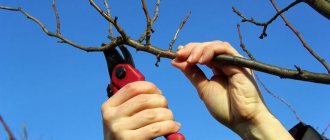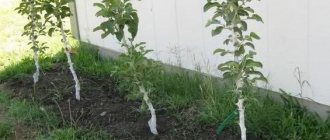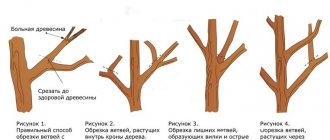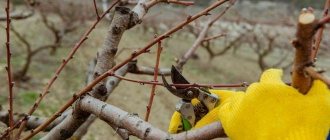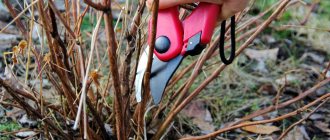Among the most important agrotechnical activities is tree pruning.
Dear readers!
For you, we have created communities on social networks in which useful articles and interesting ideas are published several times a day! Subscribe and receive useful content in a convenient format! It is necessary for sanitary purposes, for designing and decorating the crown and increasing productivity due to the redistribution of nutrients.
We will tell you about all the intricacies of this procedure in the fall in today’s article.
When to prune apple trees in the fall
When choosing the timing of the procedure in the fall, you need to focus on the condition of the tree. When the apple tree sheds its leaves, then pick up the tool to carry out the procedure.
ON A NOTE.
During the period of yellowing and falling of the leaves, the movement of juices stops, so filing the branches will not cause much damage to the plant.
In this case, filing is carried out at positive temperatures. It is impossible to remove branches in frost. The fact is that saw cuts need about 10-15 days to dry. Therefore, if you cut down the branches too late, the apple tree may freeze.
If you do not have time to prune trees at the appropriate time, then cut down small branches with a diameter of up to 20 mm, and postpone full pruning to the spring months.
How to choose the right time
So, we have decided on the approximate timing of pruning in the fall. This is the period after leaf fall. Depending on the region, this could be any of the autumn months.
Now you need to choose the right day.
It is better to prune on a dry day. It is also advisable that there was no rain at least a day before. This requirement is due to the fact that wet wood is difficult to saw. Torn cuts remain, which will then take a long time to heal.
Let us remind you once again that there should be at least 2 weeks left before frost.
If in gardening you are guided by the lunar phases, then you need to be aware that pruning of branches in the fall is planned for the waning moon.
The fact is that during this lunar phase the juices move to the roots, and cutting down the shoots will not cause too much damage to the tree.
At the same time, during the full moon and new moon, filing branches is strictly prohibited.
What types of apple tree pruning are there?
There are several types of sawing apple trees in the fall. Let's sort them out.
Shortening pruning
This type of filing protects the tree from being overloaded. You simply shorten the fruiting shoots.
Thanks to this autumn pruning, branching improves and changes the growth pattern of shoots.
Thinning pruning
Old, dry, diseased shoots that thicken the crown of the apple tree are removed.
Weak pruning
Young specimens are exposed to it. Branches are shortened by 25% in autumn.
Medium trim
Suitable for main fruit-bearing apple trees. Its goal is to increase the number of fruiting branches. Also, with the help of such filing, a crown is formed.
The branches are cut to a third of their length.
Heavy filing
Applies to old apple trees. Needed for sanitary purposes.
Formative
With this method of filing, the crown of the plant is formed. This is not only necessary for aesthetic purposes. Thanks to a properly formed crown, the tree becomes more resistant to wind and a large number of apples.
Sanitary
This means cutting out branches that are damaged in any way and compete with each other. This makes the crown sparse. Sunlight and air penetrate inside, which has a beneficial effect on the yield, size and taste of apples.
It is also applied to trees damaged by wind and thunderstorms, which can bloom and produce apples again.
Rejuvenating
It is necessary for new shoots to grow on old branches. By shortening them by only 15 cm, you stimulate the formation of additional buds.
In what cases does an apple tree need anti-aging pruning?
Any trees and shrubs can and should be rejuvenated, especially if they bear fruits that you like. But how do you know if the time has come for such a complex agricultural practice? Apple trees do not have a certain age when they need to be rejuvenated. If you shorten the shoots every year, thin out, remove old and dry branches, then your tree will develop well and bear fruit for up to 100 years. Of course, this requires watering, fertilizing and protection from diseases. But it depends on pruning how often and severely the apple tree will get sick, and whether it will have enough strength (nutrition) to plant and grow a rich harvest. Trees that grow on their own, without pruning, may need rejuvenation 15 years after planting.
We are talking about ordinary apple trees, growing as a classic tree 5–10 m high. There are also columnar varieties, the average lifespan of which does not exceed 10–15 years, and dwarf varieties, which maintain productivity for 20–30 years.
Today, a service is developing - pruning and restoration of old trees, since this work requires not only skills, but also great physical effort
It is not necessary to neglect the tree to such an extent that you already doubt whether it is even capable of continuing to exist. There are many signals with which the apple tree lets you know that it needs help:
- The tree has grown to 6–10 m.
- The crown is dense, consists of many branches intertwined with each other, some of them are dry.
- Annual growths (young shoots) are absent or few, they are short (less than 25 cm).
- Flowering and fruiting occur only at the top of the trunk and at the ends of the branches.
- The apples are small.
- The tree stopped blooming and bearing fruit.
If your apple tree shows at least 2-3 symptoms, then it’s time to start radical pruning.
Popular methods of pruning apple trees
Now let's talk about ways to cut down apple tree branches in the fall.
There are 3 main ways.
- On the kidney.
We shorten the branch to activate the growth of the side branches, which will make the crown more voluminous. Most pruning is done on the outer bud. That is, they cut down a branch above a bud that looks outside the crown. The cut is made 1.5 cm from the kidney and at an angle of 45 degrees. - On the ring.
The branch is sawed along a ring-shaped bead at the point of connection of the branches. The main thing is to make sure that there is no hemp left at the cut site. When filing thick or long branches into a ring, first shorten the shoot, and then make a cut into the ring. - To the side escape.
We saw off one of the two adjacent branches, making the main one that grows sideways.
Other methods
How to prune an old, very tall apple tree
In this case, the main actions of the gardener remain pruning excess shoots and reducing the crown of old apple trees.
Tall and old apple trees are distinguished by the presence of a bare center, which is formed due to lack of lighting. Therefore, at the first stage of rejuvenation of this type of tree, a procedure is carried out to reduce the height by at least a third. This causes the growth of new branches and improves light access throughout the entire diameter of the crown. In this case, you should adhere to certain rules:
- In one year, no more than two large branches are removed at a time. Large ones include shoots 10 cm thick.
- Small shoots are cut under the bud.
- Young shoots are left for the next pruning, the rest are removed to a side bud for vertical growth.
- Be sure to cut off the branches and ensure that the branches are subordinated to each other.
In addition, all branches that have lost their ability to grow must be removed. The cuts are made at an angle of 45°.
How to rejuvenate an old apple tree: rules and pruning patterns. How to rejuvenate an old apple tree: pruning scheme, feeding. How to care for an old apple tree
Shock pruning for rejuvenation of old apple trees
This method is suitable for old neglected apple trees that practically do not bear fruit. Such trees have a spreading crown and reach a height of 12 m. Shock rejuvenating pruning is carried out for plants with a strong central conductor and healthy side shoots. There should be no cracks, lichen or hollows on the trunk.
Important! After shock pruning, the apple tree requires a lot of effort to recover. The crop is susceptible to disease and freezing in winter and may die as a result.
The procedure for shock pruning for apple tree rejuvenation:
- First, sanitization is performed: old and broken branches are removed.
- The central conductor is shortened to a height of 3.5-4 m. 2-3 thin shoots are left under the cut. The top is cut off in several stages so that it does not cause damage if it falls.
- The remaining skeletal shoots are shortened to 2 m. It is advisable to leave fruit-bearing branches at the age of 3-4 years.
- The cut areas are treated with garden varnish.
- In the spring, the trunk is cleaned and whitewashed.
Maximum pruning and when is it needed?
Maximum pruning is carried out only after any climatic disasters. After a hurricane, freezing rain, severe hail, severe drought, extremely cold winter, or fire. Only such drastic incidents give permission for maximum voluminous pruning.
In this case, everything broken and dead is removed to make healthy wood. All other reasons should not push the gardener to radical pruning. From such pruning, especially when carried out by beginners, nothing but harm to the tree can be achieved.
In conditions of such pruning, it is very important
to remove all diseased and damaged branches and twigs , that is, to free the apple tree from unnecessary load.
Gentle
How to rejuvenate an old apple tree: rules and pruning patterns. How to rejuvenate an old apple tree: pruning scheme, feeding. How to care for an old apple tree
This processing method takes a very long time, taking at least five years. Involves eliminating old branches. It is allowed to trim apple tree shoots to a length not exceeding two meters. Annual pruning of thick branches leads to the fact that the tree is constantly in a state of stress, its productivity decreases sharply, and an increase in fruiting of the apple tree can be seen only after 5 years - when the pruning of old branches is completed.
Modern way
This method of pruning old apple trees follows the following scheme:
- Trim off most of the south-facing crown of the tree. Leave a sector about 3 meters high and 2 meters wide.
- Limited to a minimum number of cuts.
- All cuts are lubricated with garden varnish to avoid chapping of exposed areas, evaporation of nutritious juice, and also to protect them from infections.
- Simultaneously with crown rejuvenation, this method involves rejuvenation of the plant’s root system. To do this, cut off all the roots of the tree, which are found at a depth of up to 70 cm in an area about 4 cm wide. Cutting out the roots should be done from the side of the trimmed crown.
- A few years later (after the yield has been restored on the southern side of the crown), the above-ground part of the tree oriented to the north is pruned according to a similar pattern.
Spring and autumn schemes
If the tree is not neglected, it does not have pronounced problems, but the fruits have become smaller, they have lost their original taste characteristics, seasonal rejuvenation can be carried out. The pruning pattern will depend on the time of year. In spring, it is undesirable not to touch the main central branches, especially if sap flow will soon begin. It is important to remove too high shoots, side shoots, and so-called competitors. It is important to leave the central part of the tree with the strongest formations that are capable of bearing fruit this season.
Note! After the buds open, you need to conduct an additional examination, then remove everything that has frozen.
In autumn, more radical rejuvenation is permissible. During this period, you need to remove all those branches that have the wrong direction of growth. All side growth that has formed over the summer is also cut out. Leave 1-2 side branches as main branches for the next season.
Apple trees require special attention. They quickly grow side shoots, which not only spoil the appearance of the crown, but also prevent the plant from devoting all its efforts to forming a mass of crops. Rejuvenation by pruning gives excellent results if the technology is followed. To do this, you need to choose the right time, decide on the method and prepare the tools. It is important to choose a pruning scheme in accordance with the purposes of processing and the condition of the tree.
Pruning apple trees in the fall, diagrams for beginners in pictures step by step
Despite its apparent simplicity, the procedure can cause some difficulties for beginners. This is especially true for the order in which actions are performed.
Therefore, we have prepared a step-by-step algorithm for how to properly file the branches of apple trees in the fall.
Step 1.
If you have a tall apple tree, then place boards under the crown to place a stepladder on. This will prevent the soil from compacting.
Step 2.
Examine the tree. Look for broken and dry shoots. We cut them down first.
Step 3.
Find competing branches that are close to each other and grow in the same direction. Cut off the weakest ones.
Step 4.
File down those shoots that form an angle of less than 45 degrees with the central conductor.
Step 5.
Lubricate all cuts with a special protective compound.
Step 6.
Collect all the sawn branches and throw them into the fire.
Pruning old apple trees in autumn
For an apple tree 5-8 years old, it is very necessary to shorten the central conductor. This is usually done at a height of 2-2.5 m.
In addition, in the fall, branches that thicken the crown must be cut out. It is best to start with dried and diseased specimens, as well as shoots that interfere with each other.
The cut is made onto the ring.
The next stage is the removal of lateral skeletal shoots. They are either shortened to a length of 2.5 m, or removed completely if they get in the way.
Next, we cut down shoots that grow at too sharp an angle (less than 45 degrees), that grow in one direction, or that intersect.
ON A NOTE.
After all the measures described above, it is advisable to feed the plant with potassium-phosphorus complex fertilizers.
First autumn pruning
The rejuvenating procedure begins with pruning old apple trees in the fall. For beginner gardeners, it is necessary to review the detailed procedure for this process. It is necessary to remove dry, disease-damaged shoots. The branches are cut to the ground. The remaining stump can cause an infection.
Gradually you need to prune large branches. You need to follow the leading trunk. If the apple tree has sprouted several new central shoots, they must be inspected visually. If one of the new leaders is healthier and stronger than the old one, he is left. Then the old central trunk is removed.
You need to remember that no more than 3 large branches can be cut in one year. This will prevent the tree from becoming too stressed. It will be more difficult to make a mistake in this case.
Next, the scheme for pruning apple trees in the fall involves determining the optimal height of the tree. A level of about 4 m is considered optimal. If the plant reaches 6 m, it becomes difficult to prune and protect it from harmful insects and infections. If you need to shorten the crown by 1 m so that the total size is 5 m, you can trim only 30-35 cm in the first year.
The crown will also need to be thinned. All thin, dry, dead branches are removed. Each shoot is carefully examined for the presence of infections. Affected branches must be cut off.
Half
This method is practiced by experienced gardeners. It allows you to quickly and without harm to the fruit tree free the crown from unnecessary branches. Work on crown formation is carried out over two years in several stages. To renew the apple tree, in the first year it is shortened to a height of 3 m. On the south side, the crown is cut to a width of 2 m. The next year, the rest of the tree is formed in the same way.
The most developed tops are left on all branches at intervals of 70 cm from each other. The cuts are cleaned with a knife and covered with oil paint. If the width of the cut exceeds 5 cm, it is additionally covered with black polyethylene. The shelter is removed only with the onset of autumn.
Disposable
This method is also called maximum or shock pruning. This type of cutting greatly weakens the tree. Therefore it may die. One-time pruning is used only as a last resort, but it is not advisable to use it if it is necessary to remove more than half of the branches. To do this, you need to shorten the tree to the desired height by cutting off the top of the central conductor. After this, all damaged, infected, non-fruiting shoots are removed.
Important! One-time pruning is allowed only in spring. If you cut the branches of a plant in the fall in this way, it will die in the winter.
What tools are needed to carry out the procedure correctly?
For convenience, you need a minimum set of tools. In principle, one hacksaw is enough for you. But it is also advisable to get a lopper and pruning shears to cut off small knots.
All tools must be well sharpened. This is necessary so that the cuts are neat and not torn. Equal cuts take a long time to heal.
Use gloves and overalls to avoid scratching your hands.
You may also need a stepladder if the apple tree is tall enough.
IMPORTANT!
Do not use a regular hacksaw. It has a completely different tooth pattern. You need to cut with a special garden saw.
Be sure to buy garden varnish or tree paint to process the cuts.
Apple tree care after pruning
Caring for the apple tree after the procedure involves treating the cuts and cuts with special compounds. They will protect the apple tree from pathogenic microorganisms and parasites.
It is optimal to use garden varnish or tree paint. They can be purchased at any hardware store.
More putty options:
- Dye.
Ocher on olive diluted with 0.5 kg of linseed oil. - Clay chatter.
2 clay, 1 mullein + water + some chopped straw. Stir everything until it reaches the consistency of sour cream. - Concrete.
1 cement, 3 sand + water + some drying oil. - A solution of copper sulfate and lime.
10 parts lime to 1 part copper sulfate.
REFERENCE.
Cuts from old branches are covered immediately after pruning. Cuts from young branches are left to dry for a day.
Pruning a neglected apple tree
This method was developed by European specialists and consists of updating the root system of the apple tree. Root renewal is achieved by uniformly distributing fruit buds and twigs along the entire length of the branch. Then the apples have enough space for normal weight gain and ripening. At the same time, excess stepsons are removed, and the remaining ones are cut to a third of the length. For small, weakened trees, only the top part is cut off. In a properly developed apple tree, a single central conductor is left. The presence of competitors weakens the plant.
Common mistakes
- Too many branches are being cut at once.
Any pruning still causes damage to apple trees. There is no need to cut down all problematic branches at once if there are many of them. It’s better to stretch the procedure over several seasons. - Too much sawing of young trees.
On young apple trees, remove very few branches. - Sections are not processed.
To avoid introducing infection inside the tree, treat the cuts. - The procedure is carried out after rain or at sub-zero temperatures.
Cut down the shoots in dry weather so that the cuts are smooth and neat. Pruning must be done before frost.
Sanitary pruning
In addition to rejuvenation, fruit trees need sanitary pruning. To do this, remove all shoots that pose a potential danger to the apple tree. This type of pruning is necessary if an outbreak of infection occurs in the garden area or the trees are damaged by strong winds or hail. The crown is cleared of dead, broken and diseased branches. Even with a large number, they are all removed. Otherwise, the probability of tree death increases. This type of pruning is performed for fruit trees of any age.
During shearing, the shoots are cut into rings. If infected branches are to be removed, some healthy wood is captured during removal. In this way, the development of putrefactive processes is prevented. Deep sanitary pruning is necessary after a frosty winter. Frozen branches are removed to healthy tissue. The resulting plant waste is burned.
Answers to frequently asked questions
In conclusion, a couple more questions regarding the autumn implementation of this procedure.
When is it better to prune an apple tree in spring or autumn?
Filing is generally allowed at any of these times of the year. The main thing is to do this during the period when the trees are “sleeping” and sap flow processes are not occurring.
And this is either autumn after the leaves have yellowed and fallen, or early spring immediately after the snow melts.
Pruning at each time of year has its own benefits. Autumn pruning is useful in terms of influencing next year's yield and plant health. Spring pruning is good because there is no danger of the tree freezing due to cuts.
What month is the best time to prune?
It’s impossible to say for sure, since much depends on the region. The further north you go, the earlier filing is carried out. On average, you need to focus on mid-October.
Apple trees are pruned after the leaves have fallen from the branches.
